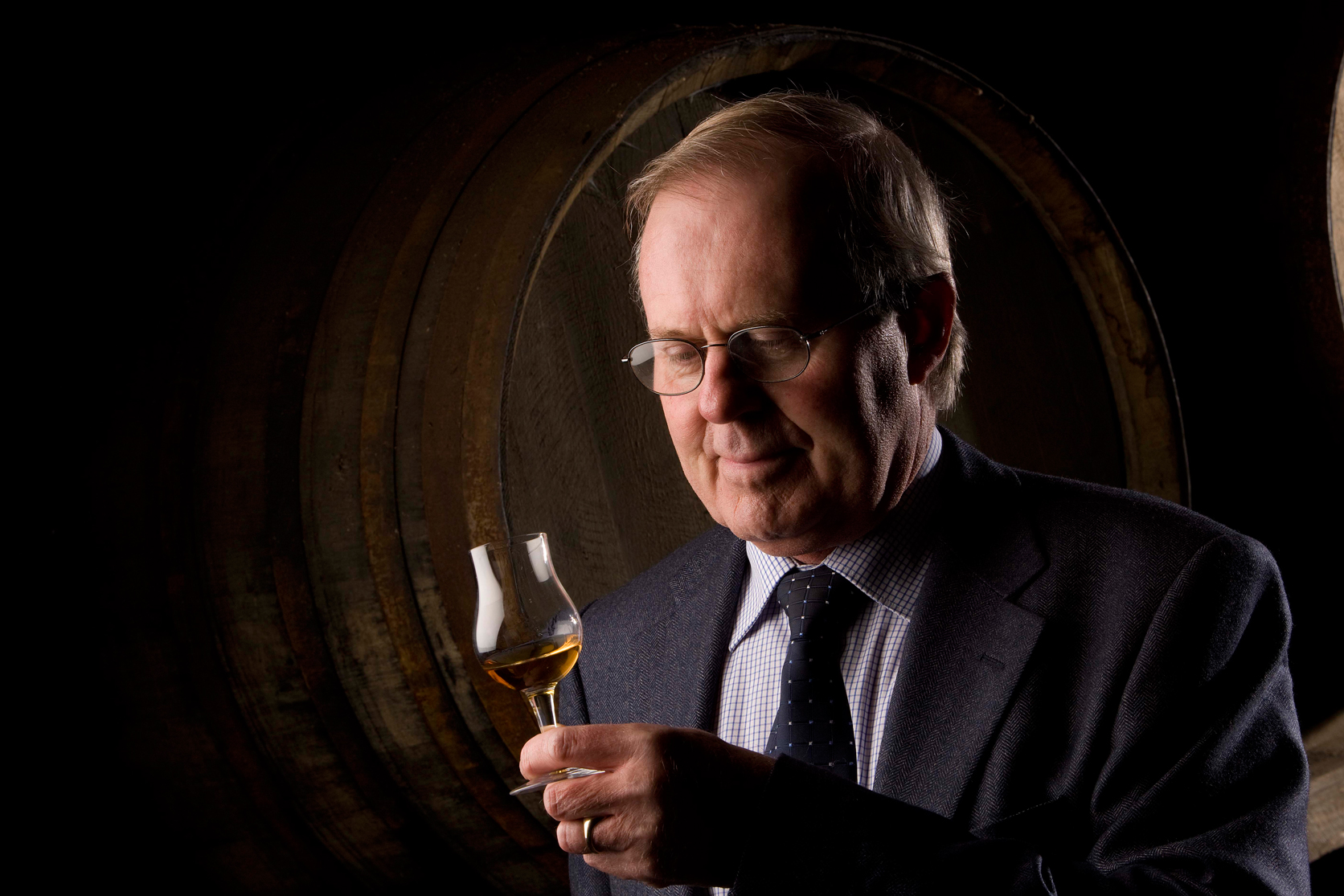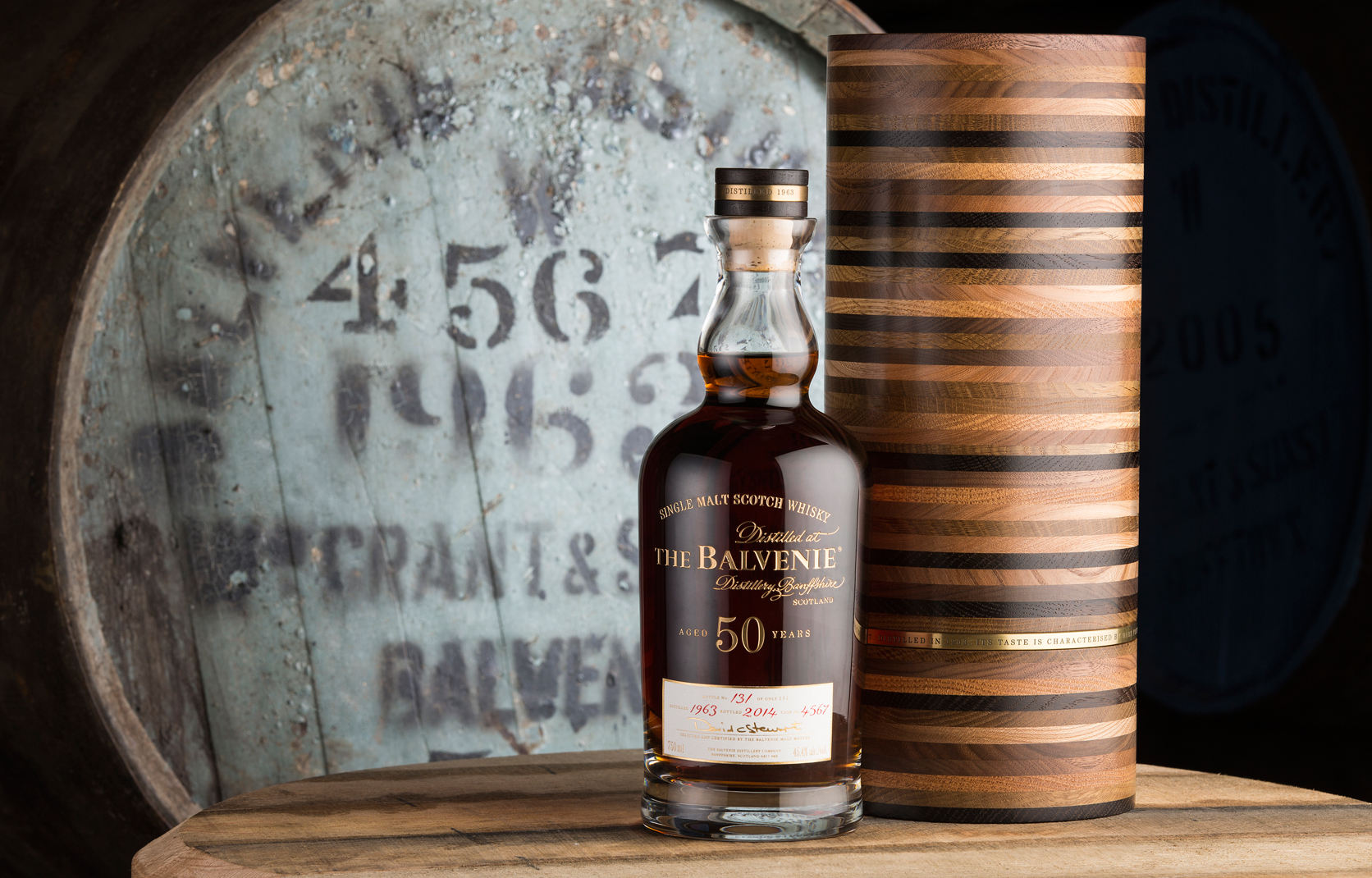Meet The Man Behind a 50-Year-Old, $42,000 Bottle of Whiskey
“Manhood is patience,” once wrote Ursula K. Le Guin. “Mastery is nine times patience.”
For living, breathing proof of that logic, look no further than David Stewart, malt master at William Grant & Sons. Not only is he responsible for every exquisite drop of Balvenie single malt whiskey, he’s also in his 53rd year on the job, making him Scotland’s longest-serving malt master. By the 70-year-old’s estimates, he noses about 30 whiskey casks a day, and has examined more than 400,000 over the past five decades. The result: a breadth of knowledge and level of expertise that makes Malcom Gladwell’s 10,000 hour rule look like The Idiot’s Guide to Proficiency.
Perhaps no other single malt better exemplifies Stewart’s seasoned prowess than the Balvenie Fifty. The man’s literally watched this whiskey mature over the last half century. Casks 4567 and 4570, both filled in 1963, were recently opened and bottled, their contents now available for purchase in Canada in extremely short supply. (There’s only one, $42,000 bottle, from cask 4567, available in B.C.). We recently caught up with Stewart, who let us know what aged perfection feels (and tastes) like.
Few people get the chance to become malt masters. What made you want to become one?
Well, I never set out to become a malt master! I joined William Grant & Sons in September 1962 as a whiskey stocks clerk. I was lucky enough to join the right side of the business — my boss was a master blender. I could just as easily have joined other areas as a clerk. My job consisted of entering data, marking off whiskey, updating ledgers, processing invoices. Then my boss, when I was 19, took me into the sample room and started to train me in the nosing aspect, which is a really important part of my role; most of the testing we do is by nosing whiskey, not drinking it. I spent ten years working the sample room, with different types of casks, ages and expressions of Balvenie. Eventually, my boss decided to leave the company in 1974, so they let me carry on just doing what I was doing. And after about six months they said, ‘Okay, fair enough, you seem to know what you’re doing — we’ll just give you the job.’ So I became the fifth malt master in the company’s history. And I’m still here.

So you’ve watched the Balvenie Fifty mature for almost the entirety of your career, haven’t you?
Yes. The casks were filled just months after I had just joined the company. We were very fortunate that it was put in a very good quality cask, even by today’s standards. But it’s really over the last decade and a half that I’ve been giving much more watch over it. Because, who would have known — if we go back just 15 years ago — there would be this much demand for that age of whiskey and people would pay such huge amounts for a bottle? We’re very lucky that they didn’t need to use those casks of whiskey for any other different products. We just left them in the warehouse. And lately, there’s been a lot more demand for older whiskey. So I started keeping a lot closer watch on these aged casks to make sure they were okay for holding onto even longer. I was checking the strength — that’s very important because we’ve lost a number of casks that have gone below 40 per cent.
The malt master’s nose gets the final say on everything.
I find it interesting that you say demand for older whiskey has shot up only in the past 10 to 15 years. Why do you think that is?
I’ve noticed there’s been more interest in single malt scotch whiskeys now than there was, say, 15 years ago and beyond. That’s why we’ve got brand ambassadors all over the world now telling people how we produce our whiskeys and treat them. A lot of those people who drink single malts want to know more and more about it. Where does it come from, what does it taste like, how do you create it? Sherrywood? American oak? And around the world I’ve met lots of collectors of single malts, from Taiwan to Russia to Canada. They want to get something no one else has. There are people who buy whiskey for investment purposes. But I make whiskey for people who drink, really. How many people actually open this bottle of Balvenie Fifty, I’m not sure. (Laughs.) Maybe some people are keeping it for their 50th birthday, or 50th wedding anniversary, or birth of their first grandchild. Some big occasion to splash this whiskey open. It’s a way to mark a special moment in one’s life.
Is there a high likelihood of failure when you age something for this long?
There can be. A lot is lost due to evaporation. These casks hold 250 litres and we’ve managed to get roughly 130 bottles out of each. So for each cask, we’ve lost about two-thirds, or 60 per cent, through evaporation. Some casks fail on strength, others are overly oaky. There’s not much you can do to prevent it, really! Some people experiment by shrink-wrapping the wood, which might stop evaporation loss, but on the other hand, it won’t mature well — the air needs to be permeating through the wood to mature the whiskey properly. So really, you just have to let nature take its course. Both of the Balvenie Fifty’s casks were filled in the same day, yet are quite different in character. So cask 4567 is 45.4 per cent strong and yielded 131 bottles, while ask cask 4570 is 45.9 per cent and got 128 bottles.
Were you surprised at all when you finally tasted the contents of these casks?
I was! Both casks were filled on May 28, 1962. You can see the cask numbers are only three apart. So 4567 was a European oak cask, and it’s got more of a ginger spiciness — it’s oaky, rich and deep. But it also has a sweetness to it; there’s notes of blackberries in there. Whereas 4570, which was an American oak cask , has more of a vanilla toffee, brown sugar, blossom honey, delicate sweetness. But with a slightly citrusy, tangy edge. So we were quite surprised. 4567 is darker in colour than 4570. But we don’t really have the history of these casks. Normally we know how many times they’ve been filled, but in this instance, because it’s been so long, no one really knows. But for me, I’d say 4567 might have been filled one time less than the other. The more you fill a cask, the more intense the whiskey becomes. All I know is we have two very different, but very nice, Balvenie whiskies.
Do you have any barrels sealed to age more than 50 years? Is that even possible?
We have got some barrels that were filled a little before 1963, and we’re keeping a watch on them. So we could do something older than 50. But these decisions are not really mine. I just keep reporting back on the quality of them and it’s up to the brand team to decide what we want to do. If there was an issue of the strength perhaps going too low, then we might make it more of a priority. It all depends on the strength, really. That’s the key. If the quality is right and the strength stays above 40 per cent, then there’s really no limit. We have good whiskey, so we could do something even older.
You’ve been at this for over 50 years. What does one gain after doing something for that long?
It’s quite a unique role, you know? It’s all about your senses. There’s a lot of using your nose. There’s a really long training period for that. And that’s another thing I like about this business: nothing can be rushed. You have to be really patient, and willing to experiment. Whether putting whiskeys into casks, or working on fortified wines or ports, these experiments all take months, if not years, to actually come to fruition. Of course, on some occasions you get disappointments — it doesn’t work and you have to start all over again. But to me, it’s been wonderful. I’ve been given the freedom to experiment. There are thousands of people who work in this industry, who never actually see whiskey. You can work anywhere, whether it be accounting, customer relations, human resources, IT — but to actually work in the sample room of a whiskey company, working with the whiskey, is quite a privilege. It makes me quite proud to have held onto my role for this long. The malt master’s nose gets the final say on everything.










